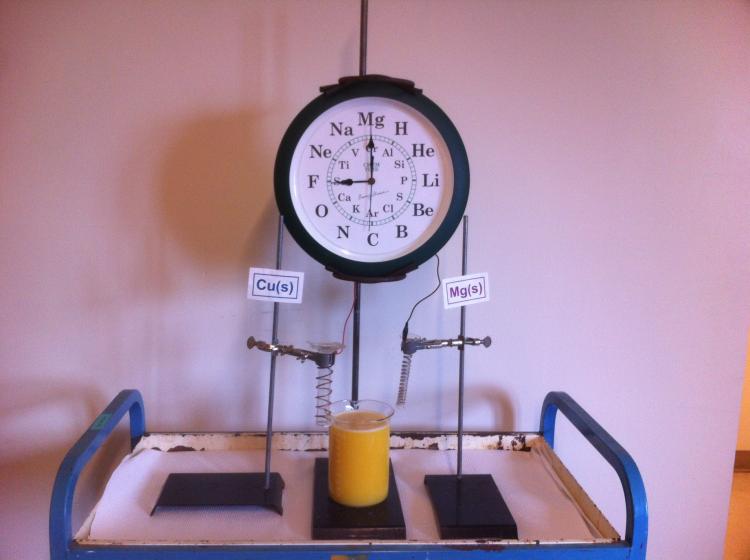X825: Orange Juice Clock
Introduction
The reaction releases two electrons (oxidation of Mg) which then power the clock as they pass through the circuit. At the other end it reduced the H+ ions in the acid to H2 gas. You can see bubbles in the solution. The Cu does not participate since there are not Cu ions in solution. A carbon electrode can be used in place of the copper electrode to illustrate this point.
Oxidation: Mg → Mg2+ + 2e-
Reduction: 2H+ + 2e- → H2
Supplies
Short List
- Orange juice
- Plastic zip ties
- 10 mL graduated cylinder
- 25 mL graduated cylinder
- 2 ft. Copper wire
- 2 ft. Magnesium wire
- 1L beaker
- 2 small ring stands
- 1 large ring stand
- Clock
- 2 ring clamps
- 2 utility clamps
- 2 alligator clips and wires, black and red
- Paper towels
- Goggles
- gloves
Prior to Lecture (prep time ~ 10 min.)
1.Materials Needed:
- Concentrated frozen orange juice
- Copper electrode (positive—red) (2 ft. of heavy copper wire wrapped around 25 mL graduated cylinder held in place by plastic zip ties)
- Magnesium electrode (negative—black) (2 ft. of magnesium ribbon wrapped around 10 mL graduated cylinder held in place by plastic zip ties)
- 1-L beaker, not tall form
- 2 small ring stands on each side
- 1 large ring stand to hold clock
- 2 ring clamps for top and bottom of clock, pad the clock to prevent marring if desired
- 2 utility clamps to hold electrodes
- 2 alligator clip wires—one red and one black
2. Equipment Set-up
- Using utility clamps, secure each probe to a separate small ring stand
- Using ring clamps, secure clock to the large ring stand (remember to use tubing to cushion clock from ring clamp)
- Place 1-L beaker in front of clock
- Poise probes above beaker on each side of clock so that instructor can lower them into the orange juice at desired time
- Clip red wire to copper electrode and cathode side in back of clock (where battery would be used).
- Clip black wire to magnesium electrode and anode side in back of clock (where battery would be used).
3. Before lecture, prepare orange juice according to instructions on label and fill the 1 L beaker
To Conduct Demonstration
Drop electrodes into juice in beaker. Attach leads if not already in place. The electrodes should be as fully immersed as possible to power the clock.

Safety and Disposal
There are no safety hazards or special disposal procedures required for this demo.
REFERENCE:
http://jchemed.chem.wisc.edu/JCESoft/CCA/CCA3/MAIN/OJCLOCK/PAGE2.HTM
http://www.nku.edu/~sieveb1/demos/ojclock/ojclock.htm
Revised 3/2016

